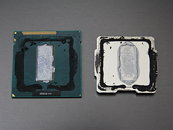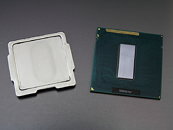Saturday, May 12th 2012

TIM is Behind Ivy Bridge Temperatures After All
It's proven: the thermal interface material (TIM) used by Intel, inside the integrated heatspreader (IHS) of its Core "Ivy Bridge" processors are behind its higher than expected load temperatures. This assertion was first made in late-April by an Overclockers.com report, and was recently put to test by Japanese tech portal PC Watch, in which an investigator carefully removed the IHS of a Core i7-3770K processor, removed the included TIM and binding grease, and replaced them with a pair of aftermarket performance TIMs, such as OCZ Freeze and Coolaboratory Liquid Pro.
PC Watch findings show that swapping the TIM, if done right, can shave stock clock (3.5 GHz, Auto voltage) temperatures by as much as 18% (lowest temperatures by the Coolaboratory TIM), and 4.00 GHz @ 1.2V temperatures by as much as 23% (again, lowest temperatures on the Coolaboratory TIM). The change in TIM was also change the overclockability of the chip, which was then able to sustain higher core voltages to facilitate higher core clock speeds. The report concluded that Intel's decision to use thermal paste inside the IHS of its Ivy Bridge chips, instead of fluxless solder, poses a very real impact on temperatures and overclockability.
Source:
PC Watch
PC Watch findings show that swapping the TIM, if done right, can shave stock clock (3.5 GHz, Auto voltage) temperatures by as much as 18% (lowest temperatures by the Coolaboratory TIM), and 4.00 GHz @ 1.2V temperatures by as much as 23% (again, lowest temperatures on the Coolaboratory TIM). The change in TIM was also change the overclockability of the chip, which was then able to sustain higher core voltages to facilitate higher core clock speeds. The report concluded that Intel's decision to use thermal paste inside the IHS of its Ivy Bridge chips, instead of fluxless solder, poses a very real impact on temperatures and overclockability.




219 Comments on TIM is Behind Ivy Bridge Temperatures After All
BRAVE....BRAVE...SOUL......:rockout:
My job and photo:).
I promise you it wasn't the engineers that wanted it, but the marketers and beancounters within the company. The arguments must have been something else. Shame none of that leaked out.
I'm so glad I didn't jump into IB and got my lovely 2700K. :D
Right, you heard this prediction here first: Intel will backpedal on this decision now that this is out and make a new version of IB with either better TIM or a proper solder connection. They will then offer an optional recall of these processors soon after for the fixed versions.
But it isn´t so difficult, just used an razor and cut around. About 15 minutes of work.
The 65° C of course are under 100 % load with linx.
Now i can tell something about behavior with higher Vcore.
I raised vCore from 1.32 V to 1.44 V. Temps went up from 65°C to 73°C (also raised clock to 4.8 Ghz).
Ivy bridge for me now behaves like sandy bridge did. Temps are near the same. I can push cpu now about 200 Mhz further with higher Vcore and lower temp.
I think 4.8 Ghz is the Wall for my CPU..........anyway, so it still doeasn´t clock so good like Sandy bridge.
Cool you get some results, to eb honest, but at the same time, I think that Intel has done the right thing. Many OC'ers will outright pull IHS, viod warranty, and all is good. Other will not, and will retain warranty, albeit while running slightly lower clocks and volts.
Voiding warranty for 200 MHz, to me seems not worth it?
The temps don't seem to be helped all that much with Water cooling. (this I don't quit Understand) for example I am running mine @ 4.5 Ghz 1.17v to 1.18v and I get 67c hottest core during Large FTT Prime and 71c Hottest core during 20 runs of LinX. (The rest of the cores are in the high 50c's and 1 low 60c's)
It seems with a good Air cooler people are not experiencing that much higher temps... then what I am getting at similar clocks and voltages.
Some good news I noticed is... while playing Metro 2033, BF3, and Crysis I saw the hottest core get up to 40c. (Other cores were in the mid to upper 30c's range) So while these Cpu's do get hot under stress testing they stay rather cool under normal gaming usage even overclocked.
So I just thought I would throw this out there.... I have tried re-seating my CPU block several times.... I am using a high end TIM.
The reason I am bringing this up is Because I don't know if I believe these temps are only related to the TIM under the (IHS) or not. Sure I believe that removing it will help some what... but it would on most CPU's.... so would lapping the CPU.
I think that we are all just going to have to face it.... and realize that Ivy Bridge is a warm running CPU.
On the other hand.... it sure would be nice if Intel would change the TIM being used and do a recall. It would for sure help somewhat!
If I decide not to sell this CPU.... I might try taking off the IHS for my own experiments.... but i am not sure about that yet.
BTW... Does anyone know if Intel released a Tcase temp for this CPU yet?
Without ihs they are at 73°C and that is similary like other cpus i had (q9550, i7 920, i7 950, i7 2700k)
I dont think replacing cooler, more pressure, better tim etc. will help. I tested all and nothing helped.
I just waited that someone proves that tim is the reason for the heat and not cpu itself.
As i read the news, it was clear that i have to take ihs off and im happy with it.
I would do it again..........especially cause summer comes and temps are getting hotter here.
Like, what is these chips are fine @ 90c and 1.25 V for 5 years? and what if 1.3V will kill CPU in 18 months no matter the temps....removal of IHS may actually give false security that may lead to many dead chips in the future....
I honestly can't see how:
CPU -> TIM -> IHS -> TIM -> HSF
can be cooler than:
CPU -> TIM -> HSF
wow that is lot temps diff!!
This is on AIR
A Ivy-Bridge 3770K 4.6ghz @ 1.2V = a Sandy-Bridge 2600k 4.8ghz @ 1.4
Doesnt sound that out of the ordinary even with the temps